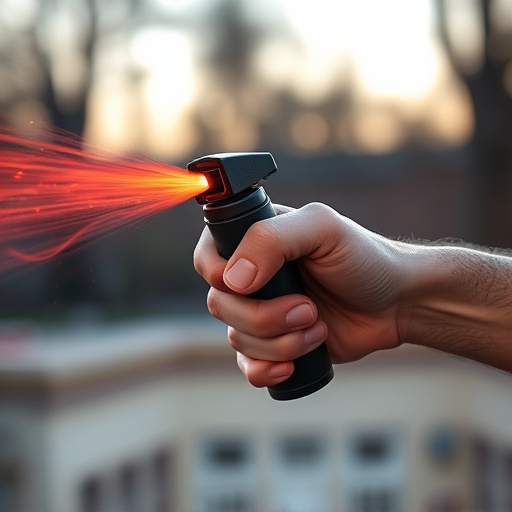Pepper spray, a popular civilian defense tool, uses capsaicin to temporarily disable attackers. Effective usage requires understanding pepper spray wind direction tips for optimal spraying, aiming at eyes and angling canisters against the wind. Choosing the right pepper spray involves considering range, potency, ease of use, local regulations, and user reviews. Maximizing effectiveness means deploying into the wind, positioning upstream to avoid self-inhalation, focusing on face and eyes, and training regularly. Adhering to legal protocols and safety practices is crucial for responsible use of pepper spray.
“Unleashing the power of self-defense in today’s world, civilian defense pepper spray stands as a game-changer. This compact yet potent tool offers individuals the confidence to protect themselves against potential threats. In this comprehensive guide, we’ll explore the inner workings of pepper spray, its effectiveness, and how choosing the right one can provide crucial Pepper Spray Wind Direction Tips for maximum defense.
From understanding composition to navigating legalities, we break down everything you need to know to make informed decisions regarding your safety.”
- Understanding Pepper Spray: Its Composition and Effectiveness
- Choosing the Right Pepper Spray: Factors to Consider
- Pepper Spray Wind Direction Tips: Maximizing Defense
- Legal Implications and Safety Guidelines for Civilian Use
Understanding Pepper Spray: Its Composition and Effectiveness
Pepper spray, a civilian defense tool that has gained popularity for its non-lethal capabilities, is a chemical compound designed to disable an assailant temporarily. Understanding its composition and effectiveness is crucial when considering its use as a personal safety measure. The primary active ingredient in pepper spray is capsaicin, the same compound responsible for the heat sensation in chili peppers. This irritant affects the eyes, respiratory system, and skin, causing temporary blindness, coughing, and difficulty breathing.
When using pepper spray, it’s important to consider the wind direction tips. Aiming correctly can maximize its effectiveness while minimizing exposure. Holding the canister at an angle and spraying into the face of an attacker, especially towards their eyes, can neutralize them swiftly. Being mindful of the wind direction ensures that the spray doesn’t blow back onto the user, providing a strategic advantage in potentially dangerous situations.
Choosing the Right Pepper Spray: Factors to Consider
When selecting a civilian defense pepper spray, understanding key factors is essential for your safety and effectiveness. One critical consideration is pepper spray wind direction tips. The wind’s direction can significantly impact the spray’s reach and accuracy. Opting for a product that accounts for this, such as those designed to counteract strong winds or with features to direct the spray, can enhance your ability to defend yourself in various environments.
Other vital aspects include the spray’s range, potency (measured in OC or capsaicin percentage), and ease of use. Consider your specific needs—whether you prioritize a longer reach or a more potent formula—and choose a pepper spray that aligns with these requirements. Additionally, check for user reviews and regulations in your area to ensure compliance and maximum effectiveness.
Pepper Spray Wind Direction Tips: Maximizing Defense
When using pepper spray for self-defense, understanding wind direction tips can significantly maximize its effectiveness. It’s crucial to deploy the spray into the wind so that the irritants are carried towards your assailant. This strategic move ensures that you’re not inadvertently blowing the spray back onto yourself. By positioning yourself slightly upstream of your target and aiming slightly downwind, you can direct the pepper spray’s path for optimal defensive coverage.
In addition to wind direction, it’s important to remember the range and duration of your pepper spray. Most civilian defense pepper sprays have a range of around 2-3 meters (6-10 feet). Aiming for the face and eyes is particularly effective as these areas are more sensitive. Keep in mind that the effect of pepper spray can last for several minutes, giving you enough time to escape or deter an attack. Practice these wind direction tips during training sessions to ensure you’re prepared when facing a real threat.
Legal Implications and Safety Guidelines for Civilian Use
When considering civilian defense pepper spray, it’s crucial to understand the legal implications and safety guidelines that come into play. The use of pepper spray is regulated by local, state, and federal laws, which vary significantly from one jurisdiction to another. It’s essential for users to familiarize themselves with these laws to avoid potential legal consequences. For instance, some areas have restrictions on who can possess and carry pepper spray, while others mandate specific age requirements or need for a permit.
Safety guidelines are also paramount, especially when aiming pepper spray. Basic tips include considering the wind direction to ensure the spray doesn’t blow back onto the user. Aiming low and slightly away from the target’s face can help minimize the risk of unintended exposure. Additionally, users should be trained in proper handling and storage techniques to prevent accidental discharge or degradation of the product’s effectiveness over time. Remember that pepper spray is a powerful tool, and responsible use requires awareness and adherence to legal and safety protocols.
In conclusion, civilian defense pepper spray can be a powerful tool for personal safety when used correctly. Understanding its composition, choosing the right product, and being aware of wind direction tips are key to maximizing its effectiveness. Always follow legal implications and safety guidelines to ensure responsible use. By staying informed and prepared, individuals can better protect themselves in potential threatening situations.
